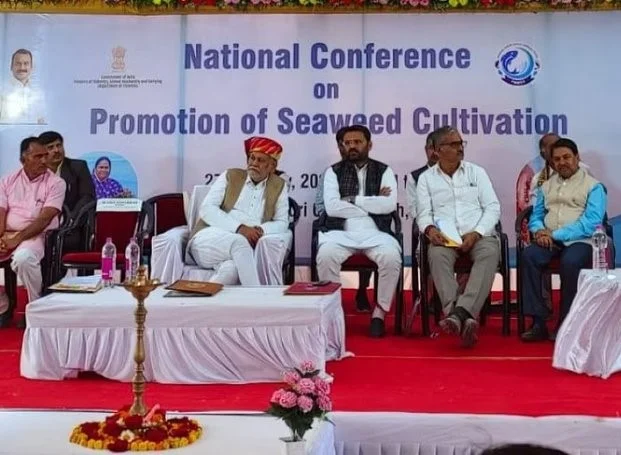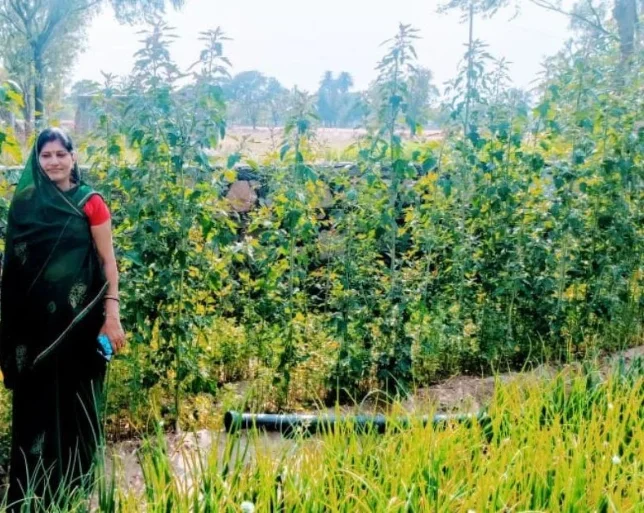Shivananda, the recipient of Kerala’s Best Farmer Award for 2022, embodies a remarkable journey rooted in agriculture. Having left school in the 10th grade, Shivananda embarked on his farming adventure at the age of 16, transforming once-empty land into a thriving agricultural haven. Initially, his father tended to a modest paddy farm in a small section of their 12-acre property.
Shivananda, along with his family, brought about a significant change in their farming practices. Despite living in a joint family setup, their children, who are well-educated and employed elsewhere, actively contribute to the farm during holidays. This collaborative effort ensures self-sufficiency, reducing dependence on external labor while yielding profitable returns from their agricultural endeavors.

A strong advocate for organic and integrated farming, Shivananda prioritizes the holistic well-being of the ecosystem. He employs organic farming techniques to convert sandy soil into fertile grounds, focusing not only on crop productivity but also on fostering healthy food, robust soils, and thriving plant life. The family’s commitment to consuming only self-grown foods speaks volumes about their dedication to organic farming.
In Shivananda’s household, the impact of organic farming extends beyond agriculture; it resonates in the well-being of the family members. Free from health issues for many years, the family’s reliance on their own organically grown produce highlights the transformative power of embracing sustainable agricultural practices. As Shivananda aptly puts it, “Organic farming is not just about crops; it’s about cultivating a healthier, more sustainable lifestyle.”

Also Read: Rajasthan Farmer Makes Rs. 4 Lakh per month from his Solar Farm Under PM-KUSUM Yojana
Farming Philosophy
Shivananda’s success in organic farming is complemented by an integrated farming system that intricately weaves together crops, animals, and subsidiary enterprises. This interdependent and interrelated production system maximizes nutrient utilization while minimizing adverse effects on the environment. Shivananda’s holistic approach to farming reflects a careful balance that ensures sustainability and productivity.
The Government of Kerala played a pivotal role in Shivananda’s agricultural journey, offering both financial and technical support. Local agricultural officers provided invaluable guidance at every step, contributing to the success of his venture. Shivananda’s meticulous planning and efficient use of the entire 12 acres of land showcase his commitment to optimizing resources.

Water scarcity is a prevalent concern in many agricultural regions, but Shivananda is fortunate to have a nearby river flowing close to his farm. This natural water source ensures a consistent and reliable supply for his agricultural needs.
Additionally, the government’s intervention proved beneficial in addressing a past challenge. A few years ago, during the summer, the farm faced the threat of saltwater intrusion due to the proximity of the sea, only five kilometers away. However, under a Kerala government scheme, the local panchayat constructed a dam, mitigating the issue not just for Shivananda but for numerous farmers in the region. This strategic intervention has had a positive impact on water management and crop cultivation, showcasing the significance of collaborative efforts in sustainable farming practices.
Upon entering Shivananda’s farm, a lush expanse of greenery greets the eye, accompanied by the vibrant presence of various bird species. These feathered inhabitants are not just charming additions; they play a pivotal role in pollination, acting as a natural deterrent to pesky insects and rodents. However, Shivananda is well aware of the delicate balance, recognizing that birds, while beneficial, can also inflict losses on agriculture. During critical stages such as sowing, seedling, and ripening, where crops are vulnerable, he employs ancient methods to manage and deter birds, minimizing the risk of economic losses for the farming community.
Also Read: MBA dropout makes Rs.13 Lakh per month growing mushroom seeds

Championing a philosophy of non-violence towards animals, Shivananda eloquently asserts, “They have the right to live on this earth.” This principled stance aligns seamlessly with the biodiversity thriving on his farm, where various crops, trees, and fruits coexist harmoniously. The abundance of nature naturally attracts a diverse avian population, creating a vibrant ecosystem. As you traverse the farm, the ambient melody of buzzing honey bees fills the air, providing a testament to their vital role. Shivananda recognizes the profound impact of bees on agriculture, emphasizing, “Bees play a big role in pollination, increasing yields and giving rise to a lucrative honey industry.”
Nestled in the heart of his expansive property, Shivananda’s house stands as a picturesque centerpiece, surrounded by lush greenery. The idyllic setting is complemented by the presence of a dairy shed and a mud-built coal storage building in close proximity.
This dairy shed serves as home to approximately 25 cows and three buffaloes, fostering a sustainable practice where, during the summer, the livestock freely grazes in the paddy fields. Shivananda ensures their nourishment by providing a diet of napier grasses and paddy straws during the rainy season. Recognizing the value of every resource, he emphasizes, “Livestock manure becomes organic fertilizer for the entire farm,” showcasing his commitment to a closed-loop and environmentally friendly agricultural system.

In a testament to the resilience and success of Shivananda’s farming journey, the education of all his children has been sustained solely through the proceeds from selling vegetables. Embracing modern agricultural techniques, Shivananda employs advanced machinery such as the attila cedar and pumps, crucial tools that have become accessible with the aid of government subsidies.
This integration of technology not only enhances efficiency but also underscores Shivananda’s adaptability in navigating the evolving landscape of agriculture. As a result, the farm not only thrives as a source of sustenance but has also become a means to empower the next generation through education, marking a profound legacy of growth and prosperity.
The mud-built coal storage facility takes on a dual role in preserving the fruits of Shivananda’s labor. Not only does it reflect the rustic charm of traditional building techniques, but it also plays a crucial role in extending the shelf life of vegetables.
Shivananda’s strategic approach is highlighted as he states, “I don’t sell my produce when the price is low.” This coal storage facility becomes a key asset, allowing him to store vegetables for a longer duration, thereby optimizing their value and ensuring a steady income. Shivananda’s house, surrounded by these functional elements, becomes a testament to the synergy between traditional wisdom and modern sustainability practices on his thriving agricultural estate.
Shivananda’s bustling dairy shed, housing around 25 cows and three buffaloes, embodies sustainable farming practices. During the summer, livestock grazes freely in paddy fields, while in the rainy season, they are nourished with napier grasses and paddy straws. Shivananda emphasizes, “Livestock manure becomes organic fertilizer for the entire farm,” showcasing an eco-friendly approach. Adjacent, a mud-built coal storage facility strategically preserves produce, allowing him to withstand market fluctuations.
Fish farming
In front of Shivananda’s house, a colorful array of flowering and medicinal plants adds vibrancy to the landscape. Just behind the house, they have established a fish tank, reflecting a growing trend in subsistence fish farming. The popularity of cultivating fish for personal consumption has surged as more individuals prioritize providing healthy, homegrown sources of food for their families. These tanks offer fish culturists a practical means to manage stocks while exercising precise control over environmental factors such as water temperature, dissolved oxygen, pH, and waste.
Shivananda, explaining the benefits, notes, “Raising fish in tanks reduces time and labor in feeding and harvesting compared to ponds.” The efficiency of small tank volumes also allows for practical and economical disease treatment with therapeutic chemicals dissolved in the culture. This water-intensive tank culture proves instrumental in achieving high yields on compact parcels of land.

Shivananda’s agricultural prowess extends to a flourishing coconut farm, where the versatile coconut tree, hailed as the Kalpavriksha, finds purpose in every part. Additionally, at the areca nut farm, a strategic layer farming technique is employed. Areca nut trees, being tall, serve as the top layer, followed by fruit trees, cocoa trees, black pepper, and banana trees, creating a harmonious mix of cash and shade-loving crops. Shivananda notes, “These shade-loving trees contribute extra income from the ground layer, where we also cultivate grass for feeding livestock animals.”

Diversifying his ventures, Shivananda manages a free-range desi chicken farm. Allowing chickens to roam freely around the farm, he capitalizes on their natural behaviors to enhance soil health, provide aeration to tree roots, and control insect pests. Emphasizing the self-sufficiency of this approach, he explains, “Chickens thrive without additional feed, producing healthy meat and eggs.” This holistic integration of various farming techniques not only showcases Shivananda’s agricultural acumen but also underscores the sustainability and efficiency ingrained in his diverse farming practices.
Adding another layer to his sustainable practices, Shivananda has recently embraced vermicomposting, recognizing it as the optimal method to transform biodegradable farm waste into a nutrient-rich goldmine, or more precisely, the best fertilizer. Vermicompost boasts a wealth of micro and macronutrients, making it an ideal fertilizer for any crop. In the rainy season, paddy cultivation takes center stage, with Shivananda overseeing the process from cultivation to milling.
Notably, they operate their own paddy mill and ingeniously utilize paddy husks as fodder for their cattle. Come summer, the same fields see the cultivation of moong, contributing significantly to their income. Shivananda underscores an added ecological advantage, noting, “The roots of moong plants are natural nitrogen fixers, enhancing soil fertility in our crop rotation techniques.” This multifaceted approach further solidifies Shivananda’s commitment to sustainable and regenerative farming practices.

In a testament to the resilience and success of Shivananda’s farming journey, the education of all his children has been sustained solely through the proceeds from selling vegetables. Embracing modern agricultural techniques, Shivananda employs advanced machinery such as the attila cedar and pumps, crucial tools that have become accessible with the aid of government subsidies. This integration of technology not only enhances efficiency but also underscores Shivananda’s adaptability in navigating the evolving landscape of agriculture. As a result, the farm not only thrives as a source of sustenance but has also become a means to empower the next generation through education, marking a profound legacy of growth and prosperity.









